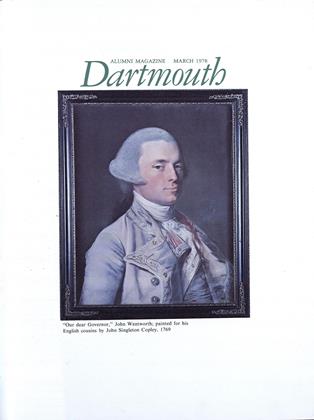The post-performance reception at Hopkins Center had the appearance of any other, but the conversation was decidedly different. While most of the people in the Drake Room chatted away in praise of the show they had just seen, several others were communicating silently in American Sign Language (AMESLAN). The sight was at least as captivating as the performance: The Three Musketeers by the National Theatre of the Deaf.
In its third visit to the College in ten years, the 14-member troupe had just finished a two-day visit which included conducting acting workshops and putting on the evening show. With four hearing and speaking members of the company providing narration and all of the characters' voices, the fairly young players (age range 20-30) tumbled and clowned their way through a loose adaptation of the Dumas classic with exuberance and skill. While some of the deaf players can speak, all of the lines are spelled out for their non-hearing audience in AMESLAN, and the blocking of the play is designed to take advantage of the natural tendency to go from AMESLAN to mime and dance.
"It's a beautiful language," said Candy Broecker, a hearing member of the troupe, who learned AMESLAN to communicate with her deaf parents. "Sometimes I prefer to sign [use AMESLAN] rather than speak, because you can use your body, your hands, your face so much more." And, in fact, she would often unconsciously break into AMESLAN while she talked. "See what I mean?" she said, laughing.
Another hearing player, Charles Jones, couldn't understand why deaf people were considered handicapped. "Man, I feel sorry for you that you can't sign!" he told us.
That did it. Determined to learn some AMESLAN before the evening was out, we joined a game of sign-language "telephone" in the corner. AMESLAN is not easy to speak or understand — the economy of movement is tremendous — but our deaf teachers were patient and before long we were able to tell them, without a word, "You were fantastic!"
 View Full Issue
View Full Issue
More From This Issue
-
 Feature
FeatureStalking the Student Athlete
March 1978 By Dan Nelson -
 Feature
FeatureThe New Classics
March 1978 By Shelby Grantham -
 Feature
FeatureNEFERTITI
March 1978 By Ray W. Smith -
 Feature
FeatureFaces in the Gallery
March 1978 -
 Article
ArticleAn Untraditional Path
March 1978 By A.E.B. -
 Books
BooksNotes on a Yale man's journal and the 'elbowing self-conceit of youth.'
March 1978 By R.H.R.







